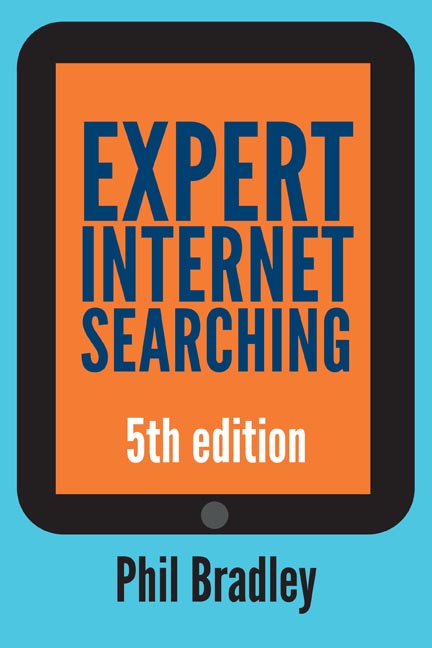Book contents
- Frontmatter
- Contents
- List of figures
- Preface
- Acknowledgements
- 1 An introduction to the internet
- 2 An introduction to search engines
- 3 The world according to Google
- 4 Other free-text search engines
- 5 Directory, clustering and similarity search engines
- 6 Multi- and meta-search engines
- 7 Social media search engines
- 8 Visual and image search engines
- 9 People-based resources
- 10 News-based search engines
- 11 Multimedia search engines
- 12 Specialised search engines
- 13 Hints, tips and the future
- Index
13 - Hints, tips and the future
Published online by Cambridge University Press: 09 June 2018
- Frontmatter
- Contents
- List of figures
- Preface
- Acknowledgements
- 1 An introduction to the internet
- 2 An introduction to search engines
- 3 The world according to Google
- 4 Other free-text search engines
- 5 Directory, clustering and similarity search engines
- 6 Multi- and meta-search engines
- 7 Social media search engines
- 8 Visual and image search engines
- 9 People-based resources
- 10 News-based search engines
- 11 Multimedia search engines
- 12 Specialised search engines
- 13 Hints, tips and the future
- Index
Summary
Domain names, URLs and web pages
Domains
Become familiar with the major domain identifiers, such as .com, .co.uk, .org and country codes. Organisations usually try and register memorable combinations of names and identifiers, but these days if they are registering a domain for the first time they may have to take whatever they can get, so if you're not finding the site that you expect at a .com address, try the .org or even the .org.uk, version for example. In the last few years the number of different domain names has increased, so we now have ones such as .accountant, .club, .help, and .science. A complete list is available on Wikipedia at https://en.wikipedia.org/wiki/List_of_Internet_top-level_domains. You can use the site: search function to limit your search to any of these new domains, and it should give you a smaller set of results, but you'll probably still need to do a more general domain search to find everything that you need.
Did you know?
The first website in the world is still online, at http://info.cern.ch/hypertext/WWW/TheProject.html.
It's worthwhile checking to see who a domain is registered to, if you have any doubts about the validity or authority of a particular site. In the UK the organisation responsible for domain name registrations is Nominet and they have a very useful Whois tool at www.nominet.org.uk/uk-domainnames/ about-domain-names/domain-lookup-whois/whois-tool that you can use to check a domain – as long as it has .uk in the address. You can see who a domain is registered to; either a person or an organisation, their address, when the domain was registered to them and when it is going to expire. It's not a foolproof method, because a registrant can pay extra to have their details redacted and it won't find addresses that end in .com either – even if they are based in the UK. If you have no luck with Nominet, do a simple whois search within your favourite search engine and it will return a variety of tools that you can use to explore domain ownership.
- Type
- Chapter
- Information
- Expert Internet Searching , pp. 209 - 224Publisher: FacetPrint publication year: 2017



